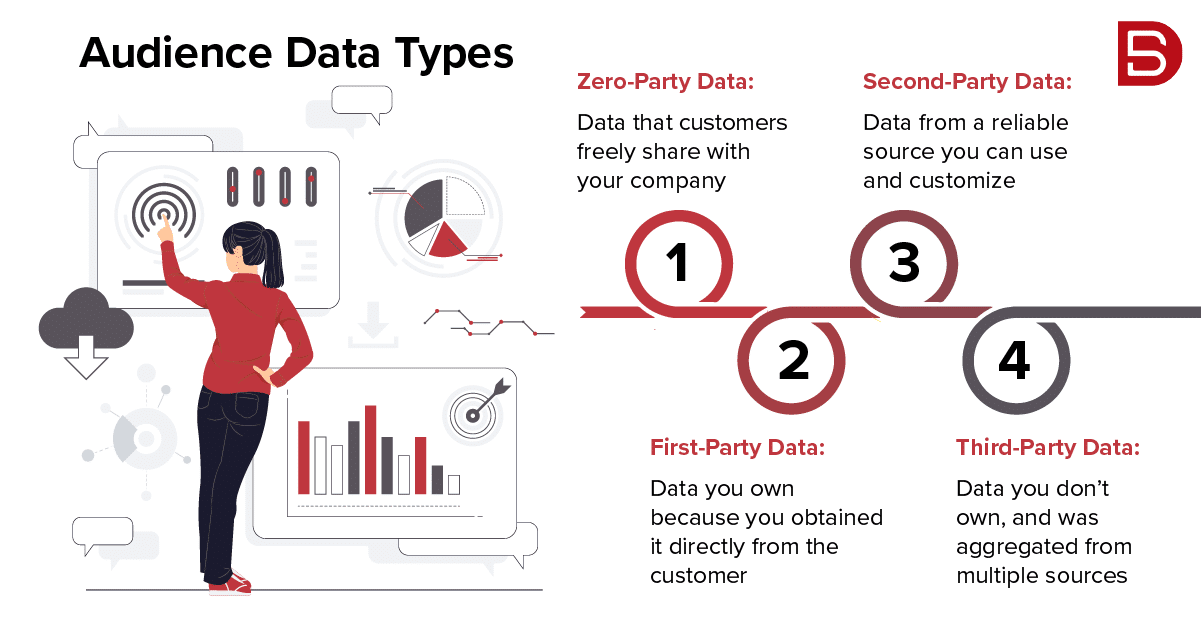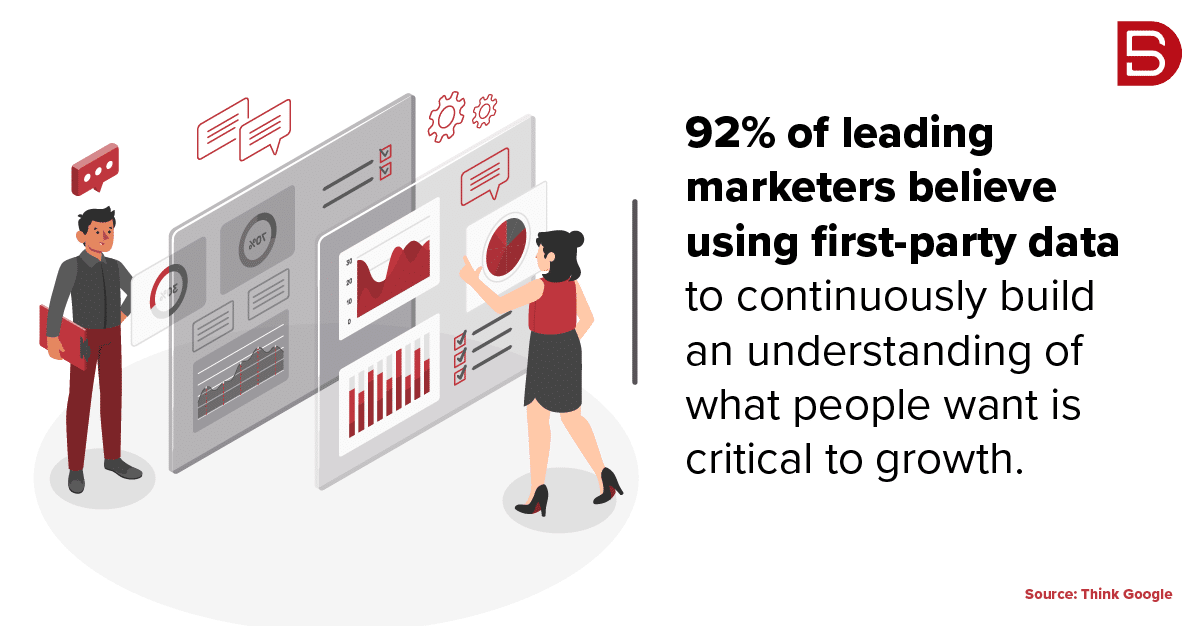First party data is essential for any B2B Account Based Marketing (ABM) strategy. Without it, you’re out of luck in understanding your target audience and attracting high-quality leads. The good news is that by harnessing first-party data, you can construct a powerful ABM approach that not only generates quality leads but also boosts your revenue significantly.
ABM is transforming the B2B marketing landscape as we know it. Over 90% of B2B marketers swear by it as a crucial value-added strategy. On the contrary, a Gartner study reveals that to keep up in an era of stricter privacy laws and fading third-party cookies, digital marketing leaders need to up their first party data game.
Therefore, the ultimate hack to stay ahead of the competition is to combine ABM with first party data. In this blog post, we will explore the importance of first party data strategies and how to make the most of this powerful resource. So, keep on reading to discover how first party data can supercharge your ABM strategy and give your marketing efforts a boost.
Table of Contents
What is First Party Data?
First party data is the data businesses gather directly from their customers and prospects. This data comes from various sources like website interactions, client surveys, loyalty programs, and even sales and marketing interactions.
When combined with account-based marketing, first party data can be used to create targeted lists of accounts and contacts for your outreach efforts. You can customize your messages for maximum impact.
And that’s not all. With first party data, you can track your progress and see how successful you are over time. It’s like having your own secret weapon to level up your ABM game!
So, consider incorporating first party data collection and usage into your ABM strategy. It’ll help you better target your accounts, add that personal touch, and keep tabs on your overall progress.
Role of First Party Data in Account-Based Marketing
Any organization looking to improve its ABM performance must implement first party data strategies. With it, you get a window into your clients’ journeys and behaviors which you can use to boost your ABM efforts.
This information can be gathered from a variety of sources, such as website visits, blog views, and email interactions. Armed with the right data, you can create laser-focused campaigns that speak directly to your key accounts. No more shot-in-the-dark approaches; this is all about engaging and converting like a pro.
Your ABM campaigns will be less successful and might even completely miss the mark without first party data. Therefore, if you haven’t already adopted this change to using first party data in your ABM efforts, it’s about time you do!
Supercharge Your ABM Performance: 5 First Party Data Strategies -
As the ABM landscape continues to evolve, so must the strategies and tactics organizations use to succeed with this approach. One area that is particularly important for ABM’s success is first party data.
There are several ways that businesses can use first party data to enhance their ABM initiatives. They can use it, for instance, to develop more specialized and targeted marketing messages, understand client needs and preferences, and monitor client response to ABM campaigns. It can also be used to build customized audiences for targeted advertisements on social media and other digital channels.
It’s important to keep in mind a few key points when developing first party data strategies for ABM. Patience is key! Gathering top-notch first party data takes time, and we want it to be accurate and comprehensive.
Next up- it’s essential for businesses to set up procedures and systems for handling and analyzing their first party data. You can use artificial intelligence and machine learning tools to analyze this data repository and create an ideal client profile.
Finally, we must play by the rules! Using first-party data means we must stay compliant with all the laws and regulations.
Now that we’ve got that out of the way, here are 5 first party data strategies that can help you ace your ABM game:
1. Power of Segmentation & ICP
The effectiveness of account-based marketing is only as good as the quality of your data. To target your ideal clients effectively, segment your audience and create targeted lists. Here’s how first-party data can help you do so:
• Define your ideal client profile
Who are your ideal clients? What do they look like? What are their pain points? It will be easier to create targeted lists once you have a clear picture of who you are trying to reach.
• Use market segmentation
Market segmentation involves dividing your audience into distinct groups based on shared characteristics, interests, or behaviors. Combining this with first-party data gives you a deeper understanding of your customers and prospects. This insight helps you identify which segments are most valuable and relevant for your ABM efforts. By targeting specific segments with personalized messages, you increase the chances of engaging and converting key accounts.
• Lead scoring
Lead scoring is a method used to rank and prioritize potential leads based on their likelihood to become customers, using numeric values assigned to various attributes and actions of a lead. It helps focus efforts on the most promising prospects and improves lead nurturing efficiency.
2. Personalization at Scale
The ability to tailor your messages and content to your target accounts is the most important component of any account-based marketing strategy. This includes being aware of each account’s pain points, needs and then adjusting your messaging accordingly.
Segmenting your target accounts based on their industry, company size, or other pertinent factors is one way to achieve this. As a result, you will be able to develop content that is specifically targeted at your ideal client’s pain points.
Further, the use of account-based marketing software can enable you to tailor your messages to specific individuals. This ensures that each message you send is pertinent to and beneficial to the recipient.
By taking the time to personalize your messages and content, you will be able to develop deeper relationships with your target accounts and position yourself as a trusted partner in their success.
3. Create Lookalike Audiences
An effective marketing strategy can be optimized using a variety of data points. First party data is crucial for developing targeted, efficient marketing campaigns because it is the information you gather about your customers and includes everything from demographics to purchase history to website behavior.
You can create lookalike audiences with the help of first party data. Lookalike audiences are assemblages of people who resemble your current clients in some ways. These audiences can be created using client lists or website tracking pixels on LinkedIn, Facebook, and other ad platforms.
Creating lookalike audiences allows you to more effectively target your marketing efforts because you know the people in these audiences are likely to be interested in what you have to offer. Additionally, first party data typically generates higher conversion rates than other forms of targeting because it is so specific.
4. Measure Success
Two crucial metrics; engagement and conversion, must be tracked to determine the effectiveness of your ABM campaigns. The frequency of interactions between your brand and your target customers is measured by engagement, while the frequency of those interactions leading to sales or other desired outcomes is measured by conversion.
Although there are many ways to track engagement and conversion, first party data is one of the best. You can use it to track engagement by calculating site time, pages per visit, and bounce rate. To track conversion, you can track past purchases, newsletter signups, and form submissions. By monitoring these metrics over time, you can clearly see which ABM campaigns are effective and which are not.
5. Evolve your ABM strategies over Time
If you want to improve your ABM strategies, there are a few things you can do to stay ahead of the competition. First, keep an eye on market dynamics and how your rivals’ strategies are changing. Second, constantly improve your understanding of what is and isn’t working by using data and analytics.
Finally, don’t be afraid to try out new strategies because sometimes making mistakes is the best way to learn. By adapting to these steps, you can be certain that your ABM strategies will always be top-notch.
Moreover, you can build long-term trust and loyalty by understanding and engaging stakeholders at each stage of the buyer’s journey.
Conclusion
The power of first party data in account-based marketing cannot be overstated. You gain valuable insights into your customers and prospects, enabling you to craft personalized and targeted campaigns that resonate with your key accounts.
If you are looking for a way to source high-quality B2B data while elevating your ABM efforts, you can write to us at marketing@datamaticsbpm.com to explore how we could help you make the best of both worlds.

James Libera



